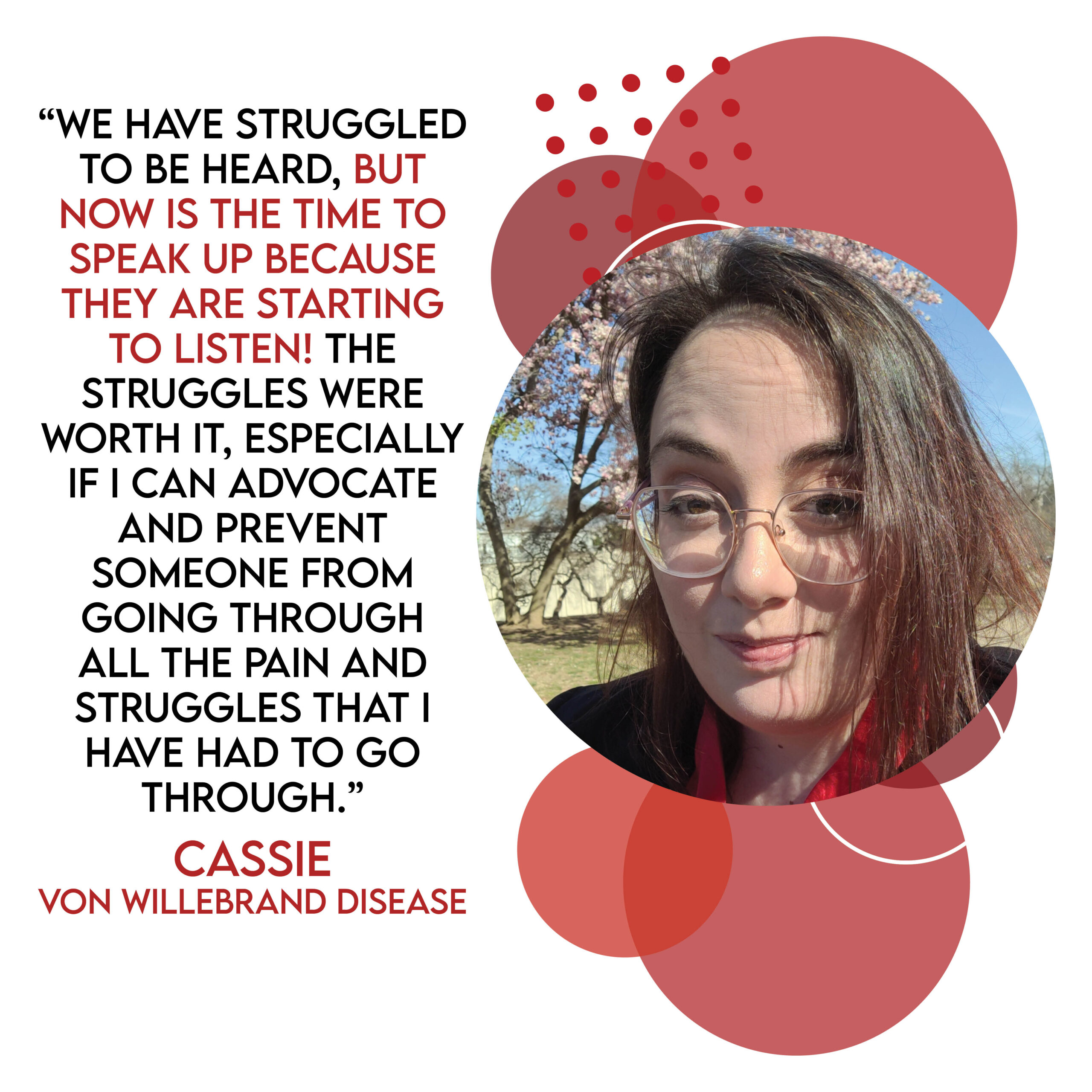At two years old, Cassie accidentally received her diagnosis of Type 1 von Willebrand Disease, severe, when she was scheduled for surgery. Before the procedure, her doctor at the time performed a bleeding time test. This test was the most common way to test for a bleeding disorder in the past. To conduct this test, a blood pressure cuff was put on the upper arm, it was inflated to a certain pressure, and a device was put on your forearm to make a small, painless cut. A stopwatch would measure the time it took for the cut to stop bleeding. Today, this test is no longer used as it is difficult to standardize and bleeding time was often normal in people, even though they had a bleeding disorder. Instead, health care providers will conduct a series of other blood tests to accurately diagnosis a bleeding disorder.
Cassie bled longer during her second bleeding time test, and her doctor referred her to a hematologist. “They went into the room and told my mom I was not going to have surgery because I would die on the table and the doctor walked out of the room,” Cassie said. No one else in her family had officially been diagnosed with a bleeding disorder at this point, so she recalls her mom being scared and curious about what this meant. Later, Cassie and her family would learn that bleeding disorders ran in both sides of her family.
Growing up, Cassie was aware of her bleeding diagnosis, but it was just something her and her family dealt with. If she got hurt, she would go to the hospital for medicine, but otherwise, she lived her life just like any other kid. Many of her complications and struggles didn’t happen until she hit puberty. Cassie’s first period lasted over three months and she suffered extremely heavy bleeding. She was taking multiple birth controls and extra factor to help control it.
“At the age of 16, I was told jokingly that I should just get pregnant to regulate my periods. Yikes!” Cassie recalls.
Cassie continued to have bleeding problems and started getting target joint bleeds. A target joint bleed is a term used for a joint that has more than 3 bleeds in a 6-month period. These bleeds went unrecognized because she was told girls don’t bleed in their joints. Cassie played sports as a child and had to fight to get prophylactic treatment, which is when a patient receives treatment regularly to prevent bleeds instead of receiving treatment in response to injuries or other bleeds.
When she entered high school, the damage was already done. She was told to stop playing sports altogether due to the significant damage done to her knees and ankles. Since high school, Cassie’s lived in braces, crutches, or a wheelchair depending on what she’s doing. Today, she receives prophylactic doses twice a week, which has helped improve her quality of life ever so slightly. She still experiences arthritis in her joints and chronic pain due to the, “wing it and see how it goes,” approach used during her childhood.
While this is difficult for both Cassie and her family, Cassie stays positive. “Having this bleeding disorder has given me access to this wonderful community. My family and I can meet up with community members, learn from them, and get advice on things we are going through.”
Cassie is a member of the Western Pennsylvania Bleeding Disorders Foundation’s Board of Directors and is a passionate Advocacy Ambassador for those affected by bleeding disorders in Pennsylvania. “One thing that I wish for our bleeding disorder community is to help get women, girls, and those [with the potential to] menstruate diagnosed early! The average age right now for a girl to be diagnosed is 16 years old,” she said. “By then, they can already have irreparable damage already done to their bodies. I would love to see girls be diagnosed early so they can be treated early. I also want it known that girls bleed just like the boys, so we should also get the same attention to care.”
Cassie feels incredibly lucky to have been born in an area where she had access to a hemophilia treatment center that focused on comprehensive care. “My story is like so many others out there,” she began. “We have struggled to be heard, but now is the time to speak up because they are starting to listen! The struggles were worth it, especially if I can advocate and prevent someone from going through all the pain and struggles that I have had to go through. Becoming an advocate has been the most rewarding “job” I have ever had!”


